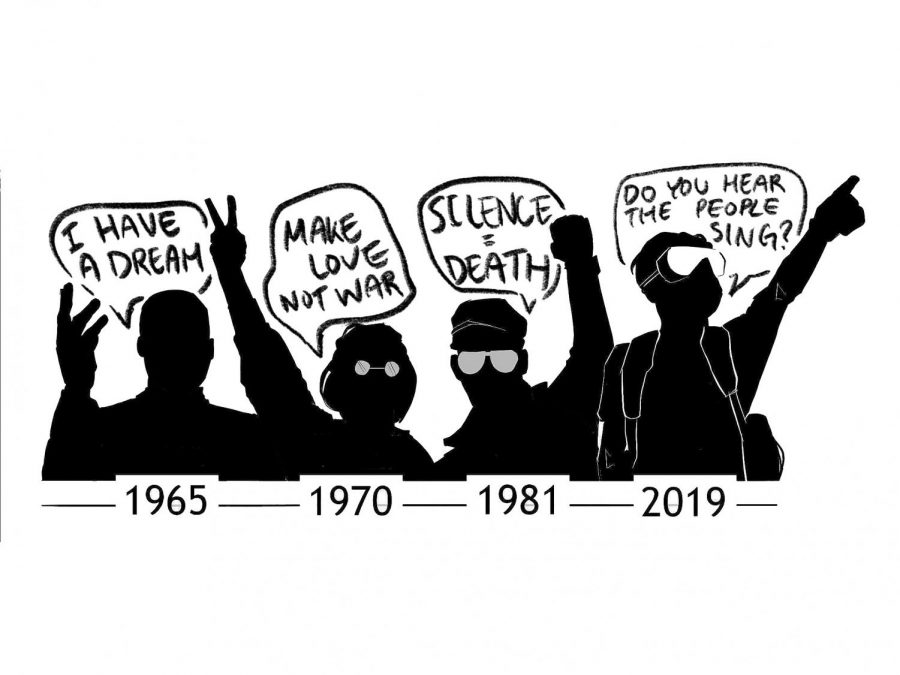Student activism, advocacy must expand beyond social media to education, discussion of issues
It’s the second week of the 2019 to 2020 school year. You open the Instagram app and begin to flip through stories but only see one type of post: “Repost on your story and we’ll donate one dollar to stop the fires.”
Chile, Hong Kong, Lebanon, single-use plastic, Amazon rainforest fire and police brutality: these are just a few of the events that have damaged or are currently damaging our world today. After news of events that infringe on human rights or raise controversy come out, countless students raise awareness by flooding their Instagram stories, but very few get involved in protests outside of the internet. While many people in today’s society believe that just posting about protests online is equivalent to “doing their part,” it raises the question of whether what they’re doing is truly effective or will cause any change. Students should partake in raising awareness by not only posting about it on social media, but actually spreading their opinions to their peers and community offline.
Activism is essentially actively campaigning or protesting to make a political or social change. However, on many platforms of social media, it is unclear whether posting will havea positive influence. Social media has provided a platform where many people can come together as a community to bring light to things happening all over the world. However, while the internet has been a great resource for petitioning and gaining thousands of signatures, it really doesn’t cause any change. As a society, we can’t forget the power of actually seeing thousands or even millions of people all over the world fight for a common cause in moving influential people to also believe in the cause and make a permanent change. The face-to-face contact, the combined passion of people, the yelling and the posters are all worth so much more than a number on a screen. Before the internet and social media even existed, those who demanded change brought together rallies of people to protest on the streets of their city; the Civil Rights movement involved 14 years of organized protest before governmental officials heard the voices of protestors and racial discrimination became illegal under the law. In comparison to that, how is one singular post going to change the world?
In March 2018, after a plethora of shootings rocked America, students, teachers and parents raced to the streets of their cities to advocate for gun control and demand change. These protests continued on, and organizations such as March For Our Lives continued to share the stories of survivors for the rest of the year. According to Gun Violence Archive, there were 343 mass shootings in 2018, and just this year, there have been 288 as of Sept. 1. Although there have been more mass shootings in America this year than there have been days, very few have raised awareness for this fact. It seems as if after everyone stopped posting about it the first time, the problem didn’t exist anymore and no one even cared that this is still such a prevalent issue in our country today. This movement, and many other movements which mainly take place online burn out so quickly that many tend to forget they even happened. However, campaigns that put hours and months into planning are able to forge human, rather than digital connection. Furthermore, just earlier this year, the Amazon Rainforest fires caused many people to donate to charities and upload pictures and videos of the fires to the internet.However, the most common reposted image stated: “For every follow and repost, we’ll donate $1 to the Amazon aid foundation.” In reality, many of these promises ended up being fake, and were just ploys to get more followers. If students really cared about this cause and how damaging it would be to the environment, why didn’t they just donate to reliable charities themselves, instead of going through an unreliable source? People seem to think that reposting or following will make a difference, when really no matter how many times a post is spread throughout the internet, it’s nowhere near as powerful as going out and speaking to inform others about the issue.
As students, it’s difficult to determine how exactly one could voice concerns about the unjust and horrifying actions that occur daily. Social media seems like it’s the easy way out—it only takes clicking two buttons to get your voice out there. But if one truly believes in a cause and is willing to fight for it, demanding change shouldn’t just stop at that. Students don’t need to actively protest everyday about what is going on, but they should speak to their fellow classmates about issues that they are passionate about. Many seem to confuse fighting for something with simply making a big scene, but it only takes one person to gather followers and create a community where common knowledge and interests are shared. Social media isn’t a bad way to relay information to millions of people; however, it’s not where activism should end, but where it should start. Students should post about what concerns them on social media, but they should also truly educate themselves about these issues and discuss them with their community. Students need to educate themselves with the injustices in our community and world in order to help make the world a better place.
Your donation will support the student journalists of Henry M. Gunn High School. Your contribution will allow us to purchase equipment and cover our annual website hosting costs.


